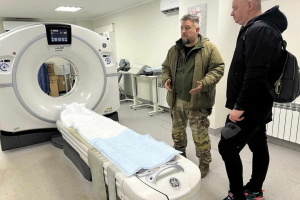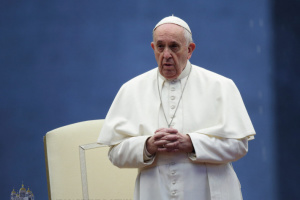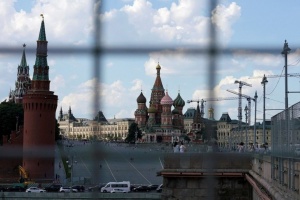
“Special Operation” Goes as Planned, 330 Meters a Day: A Digest of Russian Propaganda, as of Aug 10
The Centre for Strategic Communication and Information Security has collected the main fakes and narratives of the Russian propaganda of August 10.
The Spanish problem of Russian media
The million-dollar cigarette butt in Saki
A maths problem with many unknowns
Perm Uzbeks are ready to help Putin
The Spanish problem of Russian media
Russia regularly complains about the Western attack on Russian “freedom of speech.” Every time, it is because of yet another resource or account run by its propagandists or government structures (essentially the same thing) on social media.
The latest case concerned the Russian Foreign Ministry's English-language account on Twitter — due to the publication of excerpts from the latest briefing of the head of the radiation, chemical and biological defense forces of the Russian armed forces, Kirillov, about the alleged biological military activities of the United States and the poisoning of the ex-president of Venezuela Chávez.
The official representative of Russia’s MFA Zakharova said in annoyance that “such sanctions are used against Russia for the first time.”
IN REALITY, since the start of Russia’s full-scale war in Ukraine, Facebook, Twitter and other social networks have started blocking or restricting access to accounts of the Kremlin’s propaganda machine in the West, but this has never worked all the way.
The New York Times pointed out that social media are only preventing the spread of English-language fakes, while materials in other languages are usually not reviewed on Facebook, Instagram, Twitter, and TikTok.
Thus, pro-Kremlin narratives continue to spread in Latin America and the Middle East.
As a result, Russian disinformation spreads freely precisely in those parts of the world where the war in Ukraine is not perceived as categorically negatively as in the USA and Europe.
This policy of social networks was criticized by a group of US senators. They believe that this allows Russia to strengthen propaganda abroad in Spanish, including for the Spanish-speaking audience in the United States.
Facebook has already responded by saying it has restricted access to RT and Sputnik accounts in the EU, UK and Ukraine after receiving requests from authorities. Advertisements from all Russian state media are also blocked. The company says the same rules apply to accounts in other languages.
However, RT’s Spanish-language Facebook account has 18 million followers. This is more than the English-language website or Spanish-language CNN channels. The Arab RT Facebook account overall saw a 187 percent spike in activity during the first month of the war.
It should be noted that propaganda circumvents prohibitions in the West as well, finding other loopholes for the spread of disinformation. To achieve this, they use websites which were “hibernating” before the invasion, and then started actively spreading disinformation and propaganda.
A million-dollar cigarette butt in Saki
As predicted, the “cigarette butt” which ruined the Black Sea Fleet base in Crimea never got a proper response on Russia’s main TV channels.
The Kremlin said stop, and the “free” Russian media obeyed.
No more than a minute was given to the news about the explosions in Saki in the final evening news on federal channels. Skabeyeva’s “60 minutes,” the main talk show on Rossiya 1, did not discuss this at all.
On the First Channel, 36 seconds were devoted to the “Saki incident” in the final program “Vremya.” The main idea was, “While Kyiv pretends this is all a result of their strike, there is nothing that would point to shelling or sabotage.”
In the news on NTV and Rossiya 1, no more than a minute was devoted to the explosion and fire at the airfield, the shows limiting themselves to reporting the official position of the Russian MoD. “Evening with Vladimir Solovyov” did not even mention the emergency.
So, everyone is staying silent on the subject, rebroadcasting the official position at most.
IN REALITY, the first videos from the beach, the subsequent footage of the destroyed equipment, and even satellite images of the damage caused by the “cigarette” are very telling.
On August 10, the so-called “Crimean authorities” dared to announce the amount of financial losses from this “minor damage.” In the civil infrastructure sector alone, it is estimated at 3.5 million dollars.
Kommersant newspaper reported that in Novofedorivka, 62 high-rise residential buildings, several dozen private buildings, 20 commercial facilities and several dozen cars have been damaged.
252 people are in temporary accommodation. Gas has been cut off in Novofedorivka. Debris will be cleaned after investigation is complete.
And instead of Konashenkov, the Ukrainian Air Forces named the approximate losses of military equipment at the airfield. About 10 planes were destroyed as a result of the incident. This includes Su-30SM (costing about $30 million), Su-24MR ($5 million), Su-34 ($36 million) and Il-76 (about $83 million).
Bellingcat founder Eliot Higgins analyzed satellite footage of the base, pointing to significant destruction, many burned planes and broken buildings.
He observed at least three craters in places that could have been used as warehouses and suggested that the explosion of aeroplanes and munitions caused a massive fire that later spread through the base.
“Based on the explosions that we observed in the video, it is clear that a warehouse of munitions, aviation weapons, has been destroyed, because there was major detonation,” confirmed the speaker of Ukrainian Air Forces Yurii Ihnat.
If the warehouses also burned down (and it seems that there were more than one), the total cost of the “Saki cigarette” has already reached tens of millions of dollars.
A math problem with multiple unknowns
Hiding the truth about the explosions at the Crimean airbase is an integral part of hiding the real state of affairs at the front. On August 10, the so-called head of the “DPR” Pushilin announced the “liberation of half of the territory of the republic.”
IN REALITY, during the past month, the occupiers advanced by as much as 10 km near Bakhmut. In other areas, no more than 3 km over the same time.
After Lysychansk (July 3), no city of more-less major military significance was captured by Russian troops. In addition, let’s remember that even that disappointed Putin. Therefore, Pushylin’s winning mood is explained simply. He also needs to hide the truth and maintain the illusion that everything is going according to the “plan of the special operation.”
The question is, how long will it take Russian military to get from Lysychansk to Kyiv at this rate, considering the distance is over 700 km? Or to reach the Western border of Ukraine — Chop, for instance, is 1520 km away from Lysychansk.
Simple math tells us that Putin’s military covers 330 metres a day in Ukraine. But this rate also disregards further unknowns: rivers with bridges, which already create significant problems for the occupiers, and fortress cities with schools and hospitals which are so inconvenient for Amnesty International.
By the way, where is Amnesty International’s report about Russian troops hiding in Zaporizhia NPP, which they use to shell residential areas of Nikopolskyi district?
In addition, “allied troops” (in other words, Russian 1st and 2nd army corps in the occupied areas of Donetsk and Luhansk oblasts) should keep in mind that while they advance towards the Polish border for “full denazification,” they are likely to encounter more and more resistance from the population. And there are many such unknowns in this mathematical problem. And soon there will be more.
To ensure a more substantial advance, Putin no longer needs artillery, but combat-ready infantry. But where would he get it? The army, the Russian Guard, the FSB, people mobilised from the LPR and DPR, the Wagnerites, the national territorial battalions, and inmates have already been thrown into the battle with Ukraine.
Perm Uzbeks are ready to help Putin
Russia also doesn’t shy away from accepting help from labor migrants. On August 10, the head of the organization “Central Asian Society of Uzbeks of the Perm Territory” Jahongir Jalolov inspiredly announced the creation of a volunteer battalion to be sent to Ukraine. He explained this by saying that “Uzbeks have to justify the bread they eat in Russia.”
RT editor-in-chief Simonyan inspiredly supported the “bread cause” of the Perm Uzbeks, declaring, “If all the diasporas were like this, we would not have a national issue at all.” This is how she let it slip that by sending minorities to the war with Ukraine, Russia is actually resolving its national issue.
But Tashkent did not support Jalolov’s enthusiasm, recalling that the punishment provided for under the article “Paid participation in military activities,” according to the laws of Uzbekistan, is up to 10 years in prison.
IN REALITY, we feel sorry for Jalolov and others like him. He probably doesn’t realize that the end of this idea would be rather tragic for his community.
Ukrainians are doing everything to cleanse their land from occupiers. And this actually helps Uzbeks back home. We hope that Ukraine will be what breaks Putin’s neocolonialism and Russia’s imperial aspirations on the entire territory of what used to be the Russian Empire.




